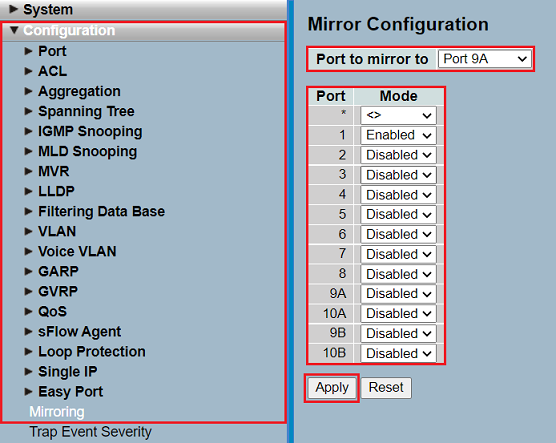Description:
To analyze the network communication it is often necessary to record network traffic at a switch port. This can be implemented via a port mirroring on managed switches. By doing this the network traffic is mirrored from one or multiple switch ports to another switch port where a network participant records the traffic for later analysis.
This article describes how to configure port mirroring on a GS-23xx series switch.
Important note regarding the capturing of data traffic on a mirror port via Wireshark on a Windows Computer
The operating system Windows cannot handle VLAN tags. Therefore a network driver is needed to enable VLAN handling. In many cases the VLAN tags are filtered by the driver, so that they are not included in a Wireshark trace of a mirror port. This can complicate the analysis of VLAN problems in a network enormously.
With some manfufacturers settings can be changed in the driver software, so that the VLAN tags are not filtered anymore. With other manufacturers changes have to be made in the registry to achieve that.
Additional information can be found on the Wireshark website.
Procedure:
1) Connect to the webinterface of the switch and go to the menu Configuration → Mirroring.
2) Change the following parameters and click Apply:
- Port to mirror to: Select the destination port in the dropdownmenu select. A computer has to be connected to this port which captures the data trffic for later analysis.
- Port: Select one or multiple source ports whose data traffic is to be forwarded to the destination port and set the Mode to Enabled. In doing so alls data traffic is forwarded to the destination port.
Instead of forwarding all data traffic, this can also be limited to incoming data traffic (Rx only) or outgoing data traffic (Tx only).
Die ausgehandelte Datenrate des Ziel-Ports muss mindestens der ausgehandelten Datenrate des / der Quell-Ports entsprechen. Ansonsten kann nicht aller Datenverkehr aufgezeichnet werden und die spätere Analyse wird stark erschwert oder ist sogar unmöglich. Dies ist besonders wichtig bei gleichzeitiger Verwendung mehrerer Quell-Ports.
Beispiele:
- Quell-Port 1 GBit und Ziel-Port 1 GBit funktioniert
- Quell-Port 10 GBit und Ziel-Port 1 GBit funktioniert nicht
- Quell-Ports dreimal 1 GBit und Ziel-Port 10 Gbit funktioniert
3. Wechseln Sie in das Menü Maintenance → Save/Restore → Save Start und klicken auf Save, um die Konfiguration als Start-Konfiguration zu speichern.
Die Start-Konfiguration bleibt auch nach einem Neustart des Gerätes oder einem Stromausfall erhalten.
Wird der Port-Mirror nicht mehr benötigt, muss dieser deaktiviert werden:
- Setzen Sie den Parameter Port to mirror to wieder auf Disabled.
- Setzen Sie den Mode für alle Ports wieder auf Disabled.
- Speichern Sie zuletzt die Konfiguration in dem Menü Save Start über die Schaltfläche Save wieder als Start-Konfiguration.

